Efforts related to products
KOSÉ strives to create cosmetic products that are “good not only to users but also to the global
environment.” In addition to setting strict standards in the selection of raw materials and
ingredients, careful research and development are also undertaken to make products that are easy to
segregate and dispose of after use, and produce less waste. Going forward, we will continue to
actively develop environmentally friendly products that adapt to climate change, while giving due
consideration to customer needs and market needs.
The KOSÉ Group is actively working to adopt packaging that conforms to the 4Rs* and to increase the
ratio of biomass and recycled resin (by resin volume) to 50% by 2030 with the aim of achieving a
100% sustainability-conscious design rate for plastic packaging.
* Reduce/Reuse/Recycle/Renewable
Activities to Improve Containers and Packaging
The container and packaging of a cosmetic product serve an important role in preserving its contents and making it easy to use. They also provide various information about the product including the product philosophy. However, cosmetic products are still consumer products, and once they have served their purpose, their containers and packaging become waste that need to be disposed of. KOSÉ is in continuous development of containers and packaging that consider environmental impacts at disposal.
Reducing the Use of Resin in Containers & Packages

We have significantly reduced the amount of plastic packaging in our best-selling SEKKISEI
Sun Protect Essence Gel, by switching to film packaging in 2014 from individual plastic
boxes. This packaging is used for many of our other products, including MAKE KEEP MIST EX.
We introduced paper packaging as part of a complete rebranding of the SEKKISEI line to
further reduce the amount of plastic used (see graph).
We are also actively adopting refills and replacements to reduce environmental impacts.
For example, the amount of plastic used in the refill of SEKKISEI Clear Wellness Natural Drip is approximately 80% less than the main container. In addition, by reducing the frequency of disposal of used containers, CO2 emissions associated with plastic disposal can be reduced.
-
(1) Example of eliminating packaging film and adopting a paper virgin seal on the outer box

When our leading skincare brand “SEKKISEI” was revamped in 2024, we eliminated the use of packaging film and adopted paper virgin seals for the outer packaging.
The amount of plastic used in “Sekkisei Medicated Brightening Essence Lotion” has been reduced by approximately 6% * for the regular size (200 ml) and 12% * for the large size (350 ml). By reducing plastic usage and switching to biomass plastic, CO2 emissions have been reduced by approximately 9%* for regular-sized products and 10%* for large-sized products.
* Comparison with current products
-
(2)Example of a compact container

Despite the smaller, compact container, the volume of content is increased. We have also adopted pouch containers that are easy to pour even without a plastic straw, reducing the amount of plastic by 0.9 g.
-
(3)Example of improvement from a transparent plastic box to a paper box

By changing the material of the box from plastic to paper, we have reduced CO2 emissions by about 5 tons.
-
(4)Examples of products using film packaging bag

Makeup products using film packaging bag
-
(5)Example of using “paper” for bag packaging

The bottom is attached so that the product can be displayed standing up as well as hanging.
-
(6)Examples of specifications for changing pumps and inner containers

Liposome Advanced Repair Serum is available in a 75-mL refill container, reducing the amount of plastic used by approximately 49%. The 30-mL and 50-mL containers are made of glass.
-
(7)Examples of using a pouch container for refilling

Compared with the standard container, a refill pouch for ONE BY KOSÉ DEEP HYDRATOR uses 89% less plastic.
-
(8)Examples of products using paper-mixed synthetic resin as cushioning material

Flora Notis JILL STUART Bitter Sweet Osmanthus Eau de Parfum & Repair Hair Oil uses paper-mixed synthetic resin as the cushioning material,
reducing the amount of plastic used by approximately 51% compared to the previous product.
In consideration of disposal, we have engraved "paper is the main material" and "burnable tray" on the new tray.
-
(9)Example of changing the material of refill trays for powder foundation
from recycled PET to paper-mixed synthetic resinCurrent product
ESPRIQUE Pure Skin Pact UV Product released in 2024
ESPRIQUE Nude Cover Long Stay Pact
The use of environmentally friendly paper-mixed synthetic resin in the refill tray reduces plastic usage by approximately 60% compared to the conventional refill tray.
*It can be disposed of as combustible waste
(10)Example of a product using a standing pouch with pouring spout
-
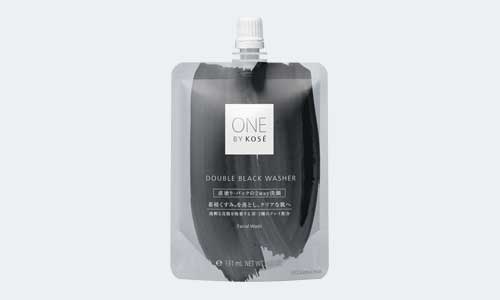
This standing pouch with pouring spout for ONE BY KOSÉ DOUBLE BLACK WASHER uses 50% less plastic compared with a tube container.
-

CT BS Black Peel Off Pack has been developed with a design that allows users to utilize every last bit of the product, providing both ease of use and environmental consideration.
(11)Examples of products using paper as container material
-

KOSÉ’s first paper cube-type container.
This has reduced the amount of plastic used by approximately 55% compared to the same container made of plastic.
Can be disassembled for disposal. -

The lid and the inside of the VISEE 30th Glamorous Layered Palette container are made of paper and placed ten eye & face colors.
Color names are printed on the back of the container for easy identification.
(12) Example of an environmentally friendly containers made with thinner walls
-

Salon style BIOLISS Botanical
Shampoo (Deep moist) BottleUses approximately 21% less resin and recycled PET generates 36.6% fewer CO2 emissions
-

Salon style BIOLISS Botanical
Shampoo (Deep moist) Large refillUses recycled PET and approximately 20% less resin
(13)Adoption of nylonless pouches
We discontinued the use of nylon which is difficult to recycle, and increased the use of mechanically recycled PET.
* It is not completely nylon-free as the bottom material contains nylon.
-

Salon style BIOLISS Pure Retouch
Payatuya Shampoo (Refill) -

Salon style BIOLISS Pure Retouch
Payatuya Conditioner (Refill)
-
(14)Shift from vacuum packaging to shrink packaging
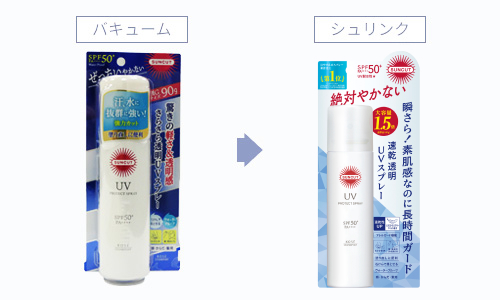
Previously the products was fixed to the mount by vacuum packaging, but the shift to shrink packaging enabled not only fixing the product to the mount but also ensuring it is unopened.
(Amount of plastic used reduced by approx. 88%) -
(15)Example of reducing plastic used upon renewal
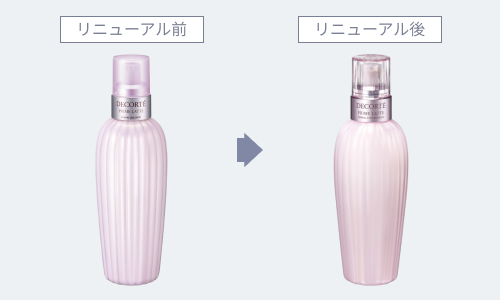
The amount of plastic used has been reduced by approximately 8g without changing the shape and durability.
Easy to refill
-
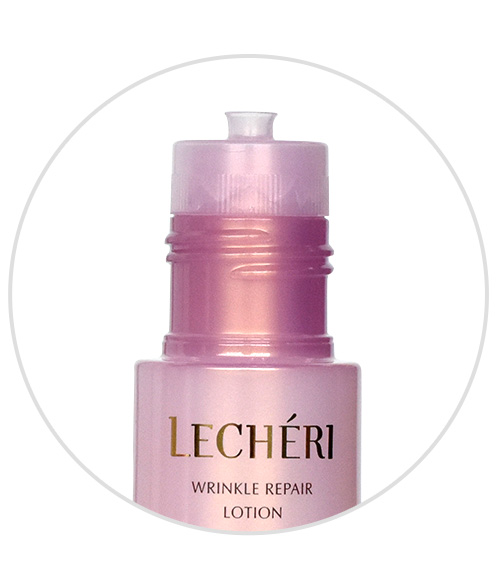
-

Container with an inner plug
that can be easily opened
We have developed a container that has a large mouth in which the inner plug can be easily opened so that non-pump type containers can be easily refilled.
Easy-to-disassemble containers made of different materials
-

-

Container desinged to be easily disassembled
Cosmetics containers made from a combination of different materials, such as metal and plastic or glass and plastic, cannot be disposed of as recyclable waste. By coming up with designs that allow each part to be separated easily, our containers are designed to make waste separation easy so that they can be recycled.
Utilization of bioplastics

SEKKISEI Clear Wellness Overnight Cream
By using bioplastics as part of the containers of our products, we are contributing to the reduction of the amount of petroleum-derived raw materials used and the reduction of CO2 emissions throughout the product life cycle.
Thus we are promoting global efforts to solve global warming issue and realize a recycling-oriented society through the use of biomass.
SEKKISEI Clear Wellness Overnight Cream, for example, uses biomass PP*1 for part of the container (inner container) through a mass balance approach*2.
The PP uses biomass-derived raw materials produced by NESTE*3, a company engaged in renewable energy business.
*1 Biomass PP
Abbreviation for polypropylene that uses renewable organic resources such as vegetable oil as raw material.
*2 Mass Balance Approach
“A method in which raw materials with certain characteristics (e.g., biomass-derived raw materials) are mixed with other raw materials (e.g., petroleum-derived raw materials) in the material-to-product processing and distribution processes, and the characteristics are assigned to a portion of the product in proportion to the input amount of raw materials with those characteristics."
(“Roadmap for the introduction of bioplastics” by the Ministry of the Environment).
For example, if 10% of biomass-derived material is used as the raw material, 10% of the product is considered to be 100% bioplastics product.
*3 NESTE
Neste Corporation is a leading Finnish energy company with strengths in renewable energy businesses including biomass business. The company has been selected as one of the 100 most sustainable companies in the world (Corporate Knights Global 100 Index) for eighteen consecutive years (as of 2024).
Use of Green Nano (Resin Additive)
Packaging (laminated bags) for SEKKISEI CLEAR WELLNESS Pure Conc SS Mask and SEKKISEI CLEAR WELLNESS 1 Day Trial Free SS, and sample packages for Pure Conc SS and CLEAR WELLNESS Refining Milk use Green Nano (a resin additive), reduces CO2 when the plastic is incinerated as waste.
Green Nano technology reduced the CO2 emissions generated during plastic incineration by approximately 60%.
-

SEKKISEI CLEAR WELLNESS Pure Conc SS Mask
-
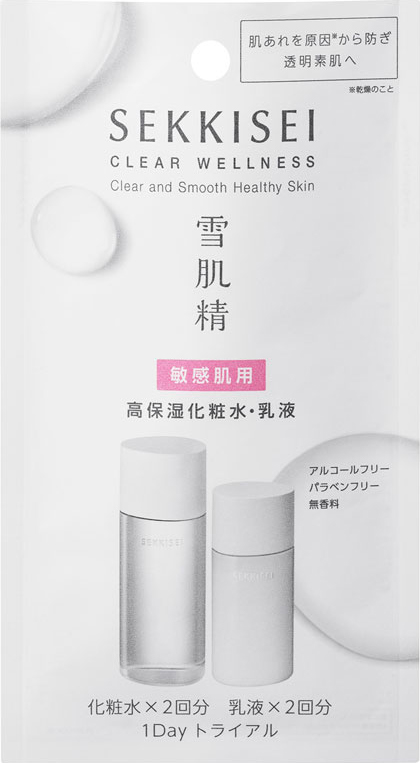
SEKKISEI CLEAR WELLNESS
1Day Trial Free SS -

Sample packages for Pure Conc SS and CLEAR WELLNESS
Use of Recycled Materials
(1) KOSÉ also manufactures cosmetic containers at our group companies. We have developed our own devices to reuse plastic leftovers from the molding process, and proactively reuse that plastic to produce caps and sample containers.
For product caps, from June 2022 we increased the percentage of recycled plastic to 50%.
Such efforts have reduced our use of petroleum-derived plastics and reduced our CO2 emissions.

Products with Caps Made of at Least 50% Recycled Plastic
-

INFINITY
Unlimited Key -

SEKKISEI MIYABI
CYCLATOR B -

SEKKISEI CLEAR WELLNESS
Face Oil Treatment
(2) KOSÉ has developed a compact case in which 94% of the plastic part is made from recycled materials.
The design combines prismatic colors that change depending on the angle of the holding hand and a serene gray to express the world of "SO PRISMATIC," the theme of our fall collection.
The delicate gray color of the body that matches the nuanced color of the top plate is also reproduced with recycled plastic.
-

The Compact Case I “SO PRISMATIC”
-
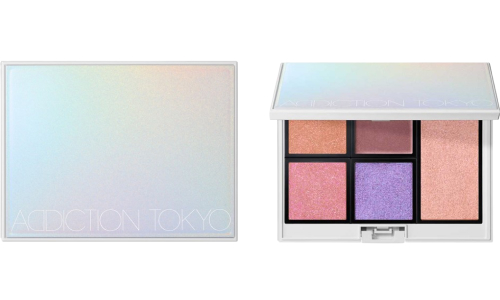
The Compact Case II “SO PRISMATIC”
(3) Use of chemically recycled PET plastic for product bottles
Some product bottles in our Prédia and SEKKISEI skincare lines use chemically recycled PET (polyethylene terephthalate). Since December 2022, we have been progressively manufacturing product bottles with this recycled PET.
Chemically recycled PET not only reduces resource use; it also reduces CO2 emissions in the manufacturing process compared with the PET commonly used for cosmetics containers and therefore represents an important initiative in consideration of the global environment.
-

Prédia
OIL DROP -
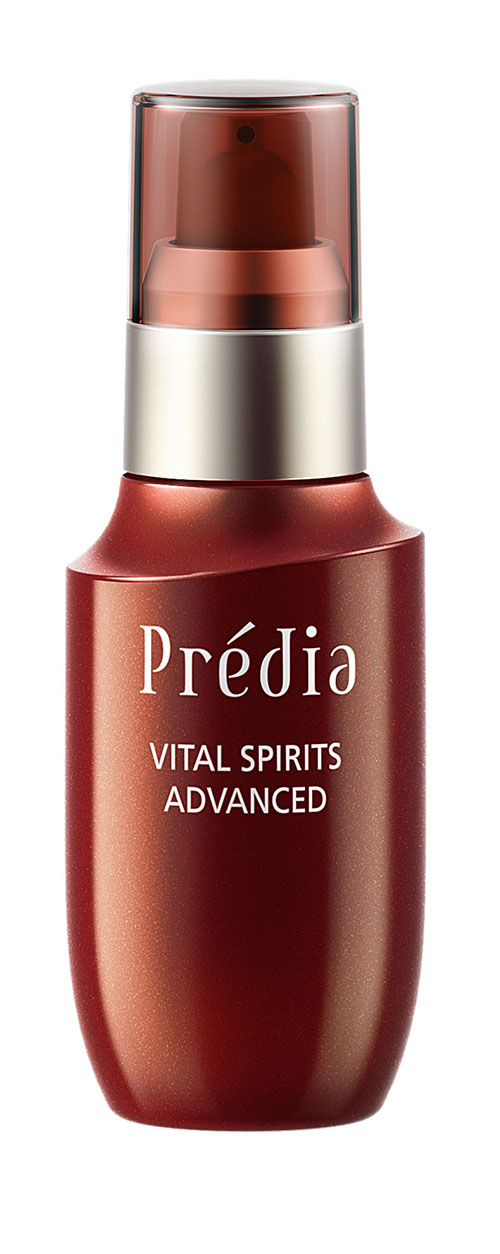
Prédia
VITAL SPIRITS ADVANCED -

Prédia
WHITE V -

Prédia
SPA et MER
G-SERUM -

SEKKISEI CLEAR WELLNESS
Gentle Wash
(4) Use of mechanically recycled PP material for product caps
The caps of the CoenRich hand cream series are made from mechanically recycled PP*.
It is made from raw materials recycled from used household products that have been approved for recycling making them both safe and environmentally friendly.
*
Recycled polypropylene is a recycled material made by sorting, grinding, and washing used polypropylene to remove surface dirt and foreign matter, and then exposing it to high temperatures to remove impurities remaining inside the resin and regenerate it.
For the mechanically recycled PP, we have requested the FDA to evaluate the recycling process. As a result of the evaluation, we have adopted substances that have received a NOL (No Objection Letter).


Products using recycled PET
(5) KOSÉ also manufactures cosmetic containers at its group companies. The company has developed its own equipment to re-materialize leftover materials generated during plastic molding and actively reuses them as materials for caps and sample containers. In addition, we are promoting the use of recycled materials for cosmetics containers and have adopted plastic boxes with the “PET Bottle Recycling Recommendation Mark” for some of our products.
Development of pumps and containers that minimize the remaining contents
By creating a pile at the bottom of the container and designing the container so that the pump pipe reaches the bottom, the contents can be suctioned up even when the remaining volume is low.

Salon style BIOLISS Pure Retouch
Payatuya Shampoo
Successfully developed a "metal-less pump"
Pump dispensers, which are widely used in cosmetics containers, are mostly made of plastic, but metal springs are used in the mechanism that plays an important role of sucking out the contents, for durability reasons. No plastic parts have been used for the mechanism because it is very difficult to achieve the equivalent performance by plastic parts.
The "metal-less pump" developed by KOSÉ, Albion, and Yoshino Kogyosho has achieved the target quality by examining materials and designing a shape that exhibits strength and performance equivalent to that of a metal spring as well as repeatedly testing the strength and durability to suck up the contents. As the first step toward mono-materialization to reduce the use of plastics that are difficult to recycle, we will use this product which has no metal parts, as a foothold to unify the materials used in packaging to reduce the types of materials used. This will facilitate sorting and collection after disposal, thereby promoting plastic recycling.

Cardboard Product Boxes

The cardboard boxes used for the SEKKISEI CLEAR WELLNESS product line use cardboard, which is said to have a recycling rate of more than 90% in Japan.
The boxes are constructed so they cannot be easily opened during transportation or display, allowing us to reduce plastic use by eliminating the outer layer of tear-tape film packaging.
Use of Recycled Paper and Certified Paper

Using certified paper
We are actively working to increase the usage rate of recycled paper in all items including single boxes of products, instructions, brochures, and cardboard boxes. For paper packages that do not contain recycled paper, paper derived from wood harvested from certified forests (“certified paper”) is used.
Proactive use of paper made from sugar cane residue

Bagasse as a raw material to create boxes
Bagasse* as a raw material to create boxes
* Paper made from sugarcane residue
Unglued Package Box
No glue is used for the package box of “JILL STUART Lip Balm” which is inspired by a mug.
Thus it is easier to disassemble and recycle.

Reduction of Package Inserts

The printing instructions are on the inside of the box and the QR code is on the side.
We are making efforts to increase the number of products that do not have a paper
instruction manual attached by directly printing an instruction manual, such as how to use
the cosmetics, on a part of the product box (outer box). Currently, many products have
adopted this method, and for some products, the instructions are also printed on the inside
of the box.
We will also digitize our products by issuing QR codes to reduce the use of paper as much as
possible.
For “SEKKISEI CLEAR WELLNESS”, we have adopted biomass ink, which is easily biodegradable
and has a low environmental impact, for printing on the product.
The notation on each box is in a size and typeface that is easy for anyone to read, using a
universal font that we have established.
Activities to Improve Product Contents
The use of plant-based raw materials and environmental impacts after use are also taken into consideration in the development of the contents of our products.
Statement for microplastic beads
Microplastic beads are used as a raw material in rinse-off cleansing products. Microplastic beads
are safe for humans, and have been used as a highly-functional raw material; however, in recent
years their potential environmental impact has been raised as a concern both in Japan and
overseas.
In consideration of the worldwide social concern, KOSÉ Group stopped using microplastic beads for
new cleansing products developed since 2014, making the switch to plant derived materials with less
negative environmental impact. Also we have completed the replacement of the traditional cleansing
products containing microplastic beads with new products. No cleansing product containing
microplastic beads has been shipped since January, 2018.
Use of biodegradable raw materials as much as possible

Use of biodegradable amino acid raw materials
KOSÉ uses biodegradable amino acid raw materials for some of its products, such as facial cleansing products and shampoos. Even if these products are emitted into rivers, these raw materials are easily degraded by naturally occurring microorganisms. They are used for almost all of the KOSÉ brands, including COSME DECORTE, GRANDAINE, Je L’aime, softymo and SALON STYLE.
Procurement of raw materials with consideration for the preservation of ecosystems

Moringa tree just after planting
For the procurement of raw materials, we focus on preserving ecosystems and supporting local communities. Products including “DECORTÉ”, “STEPHEN KNOLL NEW YORK", and “ADDICTION” are formulated with ingredients that take biodiversity and sustainability into consideration.
“Flora Notis JILL STUART” contains moringa oil extracted from moringa trees. The brand is planting moringa trees, as part of its tree-planting activities, which can absorb about twenty times more CO2 than ordinary trees.
The brand's activity policies include "environmentally conscious manufacturing," "use of CO2-absorbing raw materials," and "protection of the ecosystem through tree-planting."
* Click here to learn more about Flora Notis JILL STUART's environmental initiatives.
For the Global Environment
Top
Environmental Indicators
Initiatives to Address Climate Change
Low-Carbon Transition Plan
Measures for Circular Economy
Commitment for Biodiversity
Efforts related to products
Efforts in manufacturing
Efforts at offices, logistics operations, and shops